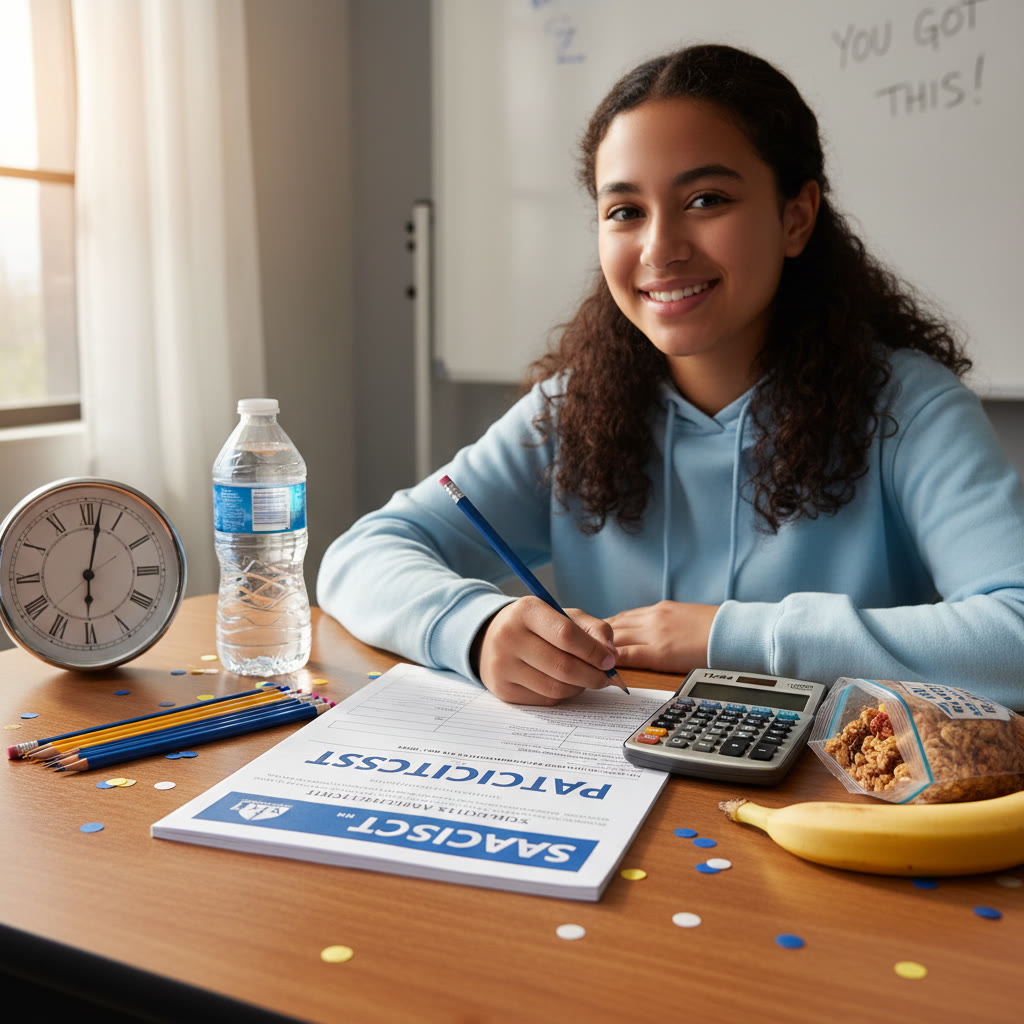Introduction: Practice That Feels Like the Real Thing
Imagine showing up to the SAT on a bright Saturday and realizing everything you rehearsed had missed one big detail: the day felt different. The quiet room, the clock, the unnatural stillness, the small surge of nervousness—those tiny differences add up and can shave points off a score. That’s why simulating test-day conditions during SAT practice isn’t an optional extra; it’s one of the most powerful, high-leverage habits a student can adopt.
In this post we’ll walk through why full test-day simulations matter, how to set them up, a practical multi-week schedule you can actually follow, what to watch for during the simulation, and how targeted help—like Sparkl’s personalized tutoring with 1-on-1 guidance, tailored study plans, expert tutors, and AI-driven insights—can make those simulations far more productive. No fluff. Just clear, usable advice you can apply starting this afternoon.
What We Mean by “Test-Day Conditions”
“Test-day conditions” means recreating the circumstances of the official SAT so your brain and body learn how to perform under those exact pressures. It includes:
- Using a full-length, official-style practice test (timed sections and full breaks).
- Testing in a quiet, uninterrupted room with a real clock or timer visible.
- Wearing typical test-day clothes and using the tools you’ll bring (approved calculator, pencils, ID, snacks for the break).
- Starting at the same time you plan to take the actual SAT (e.g., early morning) and following the same pre-test routine (sleep, breakfast, commute).
- Avoiding digital aids unless the real test allows them—practice on paper and on the official interface when relevant.
It’s not necessary to copy every single detail (you don’t have to drive in Friday night traffic), but the more realistic you make the practice, the more you condition yourself to perform when it matters.
Why Simulating Test-Day Conditions Works
1. Trains Your Body and Mind to Be Ready
Performance isn’t purely cognitive. Your body—sleep, nutrition, and circadian rhythm—affects attention and reasoning. Athletes don’t practice at a half-speed on Tuesday and expect to perform perfectly in Sunday’s game; students benefit from the same principle. By taking practice tests at the same hour as the real SAT, you teach your body when to be alert.
2. Reduces Surprises and Lowers Anxiety
Unknowns generate stress. If you’ve already sat through a four-hour, timed practice and handled the inevitable mental dips, those same moments during the actual SAT will feel familiar. Familiarity reduces the burst of adrenaline that causes rushed reading, skipped steps in math, or careless errors—especially in the last 15 minutes of a section when fatigue starts to mount.
3. Improves Time Management and Pacing
Clock awareness behaves differently in practice than in a simulated environment. Under real-time pressure you might run out of the minutes you’ve always assumed were “plenty.” Simulated tests reveal pacing blind spots: which question types take you longer, where you stall, and when it’s smarter to move on.
4. Highlights Endurance and Focus Patterns
Most students are capable of high-quality reasoning for short windows. The SAT requires sustained attention across multiple sections. Simulations reveal when your focus fades, which questions you miss when tired, and whether breaks/mini-rest routines (deep breaths, brief stretch) help. Once identified, endurance strategies become trainable.
5. Provides Diagnostic Data That Actually Reflects Test Performance
Practice under relaxed conditions can produce an inflated score. Realistic simulations give data closer to your expected test-day score, making study adjustments and tutor recommendations far more precise. That’s why Sparkl’s tutors combine simulation results with AI-driven insights to craft tailored study plans and efficient practice sessions.
Concrete Elements to Recreate
Environment
- Quiet room with a single surface to work on.
- Real clock or timer visible; use the official section timings.
- Minimal distractions: phone off or in another room, internet disabled if you don’t need it.
Materials & Tools
- No. 2 pencils (or what the test requires) and a reliable calculator you’ve practiced with.
- Scratch paper or lined notebook for working thoughts—treat it like test scrap paper.
- Proper ID and admission ticket practice—go through the motions of what to bring.
Timing & Schedule
- Start at the same hour as your real test (e.g., 8:00 AM). If your commute will be 30 minutes, include it.
- Follow the same break structure: simulate whatever break length is typical for your test day (often a brief break halfway through).
- Respect section timings exactly: do full sections with official time limits.
How to Run a High-Value Simulation
Running a meaningful simulation isn’t just about timing yourself and filling in answers. Treat it like a rehearsal with purpose. Here’s a step-by-step routine you can use:
- Choose an official, full-length practice test or a closely faithful version.
- Schedule the test on your calendar as a non-negotiable appointment.
- Prepare the night before: lay out clothes, pack materials, sleep 7–9 hours.
- Wake up at your test-day time. Eat the same breakfast you plan to have on the real day.
- Arrive early if you’re simulating a commute; set up a quiet testing space with a visible clock and no interruptions.
- Complete the test with exact timing and materials. Resist the temptation to peek at solutions mid-test or check your phone during breaks.
- After finishing, simulate the scoring ritual: score the test, record mistakes, and note patterns.
What to Track During and After Your Simulation
Collect data with purpose. Track both quantitative metrics and qualitative notes:
- Score per section and total score.
- Time spent per question type (e.g., grid-ins, data interpretation, passage-based reading).
- Number of guesses and omissions.
- Mental state notes: energy levels, points of frustration, when concentration dipped.
- Practical issues: tricky calculator function, unreadable handwriting, uncomfortable chair.
These observations let you refine study priorities: whether to drill specific question types, practice pacing, or adjust physical preparation.
Sample Multi-Week Simulation Schedule
How often should you perform a full-length simulation? That depends on how close you are to testing and how much time you have. Below is a practical plan for an eight-week block leading up to a test. The table summarizes frequency and focus areas.
| Week | Full-Length Simulations | Primary Focus |
|---|---|---|
| Weeks 1–4 | One every 7–10 days | Baseline performance, pacing, identify weaknesses |
| Weeks 5–6 | One every 5–7 days | Targeted drilling based on weakest areas; experiment with pacing strategies |
| Week 7 | Two simulations (one early, one mid-week) | Full dress rehearsals with morning routine and logistics |
| Week 8 (Test week) | One light simulation early in the week or practice sections only | Taper: rest, light review, sleep, and logistics check |
This schedule balances practice volume with recovery. The goal is not to burn out by running too many full tests; the goal is to make each simulation increasingly reflective of your expected test-day condition.
Common Problems Simulations Reveal—and Fix
Poor Pacing on the Math No-Calculator Section
Problem: You run out of time on no-calculator questions because you’re doing every arithmetic step by hand.
Fix: Practice mental math shortcuts and timed mini-drills. During a simulation, note exactly when you start to slow down and make that a weekly drill focus.
Fatigue on the Final Questions
Problem: Accuracy drops on the last 10–15 questions of a long section.
Fix: Build endurance with timed practice blocks and controlled breaks. Experiment with short mindfulness or breathing techniques during break to lower cortisol spikes and maintain clarity.
Overconfidence in Section Scores
Problem: Home untimed practice yields higher scores than timed simulations.
Fix: Use simulations to anchor your expectations. If scores drop under realistic conditions, change study tactics rather than doubling down on the same practice method.
How to Use Simulation Results to Improve Fast
After each simulation, spend 15–30 minutes debriefing. Don’t just tally scores—translate them into actionable steps:
- Identify 3 highest-impact weaknesses (e.g., algebraic word problems, passive voice questions, data analysis).
- Assign targeted drills for the next week. Small, intense work beats unfocused hours.
- Adjust your practice-test frequency based on improvements. If pacing improves quickly, focus more on content; if it doesn’t, prioritize timed work.
Sparkl’s tutors are especially effective at turning simulation data into a short, focused plan—whether that’s 1-on-1 guidance on the geometry you keep missing, a tailored study plan for pacing, or AI-driven insights that show which question types predict gains fastest.
Real-World Examples: Why It Helps
Think of rehearsal in other fields. A musician performs a dress rehearsal before a concert to practice not just notes but entrance timings, outfit comfort, and stage flow. A runner practices under the same wind and course conditions to build confidence. Simulating the SAT is the cognitive equivalent of a dress rehearsal: you’re training the whole system (cognition, body, logistics) to perform smoothly on the day that counts.
One student reported consistently missing easy reading questions late in the section because she habitually skimmed passages when tired. After three realistic simulations, she recognized the pattern, adjusted her approach (short initial pass for structure, then targeted reread for evidence questions), and raised her Reading score by 60 points in a month. That’s the kind of measurable difference realistic simulation can create.
Checklist: What to Bring and Do on Simulation Day
- Phone: off or in another room. Test the same behavior you plan on test day.
- Clock or timer: visible and set to official timings.
- Calculator: the one you’ve practiced with and know how to use quickly.
- Pencils and eraser; extra batteries or backup calculator if relevant.
- Water and snack for the break—use the same brands you’ll rely on for familiar energy.
- ID and admission-style items (good practice for the logistics of finding and presenting them).
- Comfortable clothes and a chair/table setup similar to the test environment.
When Simulations Might Backfire (and How to Avoid It)
Too many simulations without reflection leads to burnout and incremental improvements. A few ways simulations can be counterproductive:
- Running full tests daily without review—this sacrifices depth for volume and leads to fatigue.
- Practicing in a high-stress, punitive mode—if each simulation becomes an anxiety spiral, step back and include relaxation practice first.
- Using low-quality practice tests that don’t match SAT style—always favor official or realistic material for simulations.
Balance is key. The most effective students alternate full simulations with focused, short practice sessions aimed at the specific weaknesses uncovered by those simulations.
How Tutoring Makes Simulations More Effective
Self-guided practice works—but it’s far more efficient when combined with expert feedback. Here’s what 1-on-1 tutoring, like the personalized support Sparkl provides, adds to simulation-based practice:
- Objective analysis of simulation errors. A tutor can spot patterns you won’t see—like a recurring mistake in reading inference questions or a recurring algebra step you skip under time pressure.
- Tailored drills that directly address your weak points instead of a generic plan.
- Accountability to make simulations regular and purposeful, rather than sporadic and demoralizing.
- AI-driven insights that integrate your simulation data to prioritize the highest-impact study items each week.
When simulations are coupled with this kind of targeted support, improvement accelerates because you’re not spinning your wheels—you’re practicing what matters and fixing the exact things that cost points.
Final Thoughts: Treat Simulations Like a Dress Rehearsal, Not a Judgment
Simulated test days are a gift: a chance to learn where you’re likely to stumble, how your body responds, and what practical changes will increase your score. They demystify the unknown and convert vague anxiety into a plan for improvement. Done right, simulations reduce stress and make your final test day feel calm, familiar, and under your control.
If you want to make simulations even more productive, consider layering them with thoughtful tutoring. Sparkl’s personalized tutoring offers 1-on-1 guidance, tailored study plans, expert tutors, and AI-driven insights that convert simulation results into measurable gains—without extra busywork. With the right combination of realistic practice and targeted feedback, the SAT becomes less of a guessing game and more of a skill you’ve trained for deliberately.
Quick Start Plan: Your First Simulation This Weekend
If you have one weekend free, here’s a simple action plan to get started:
- Friday night: choose an official practice test, gather materials, and lay out clothes.
- Saturday: wake up at test-day time, eat your planned breakfast, and run the simulation from start to finish with a visible timer.
- Immediately after: score the test, write down 3 priority weaknesses, and schedule three short drills for next week that target those areas.
- Sunday: rest or work light drills; adjust your plan for the week based on what you learned.


Closing: Simulations Are Practice You Can Trust
In the end, the SAT rewards consistent, thoughtful preparation. Simulating test-day conditions turns passive study into a realistic rehearsal where you learn not just what you know, but how you perform. That rehearsal reduces surprises, sharpens pacing, and gives you practical data to study smarter—not harder.
Start small, be consistent, and use each simulation as an experiment: change one thing at a time, measure the effect, and keep what helps. If you pair those simulations with targeted tutoring—like Sparkl’s 1-on-1 guidance and AI-informed study plans—you can compress months of fuzzy practice into a focused path to score improvement. Treat your practice like a dress rehearsal; your test day will be the performance.
Good luck—and remember: the goal isn’t to be perfect in practice, it’s to be prepared on the day that counts.



















No Comments
Leave a comment Cancel